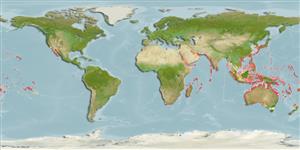Common names from other countries
Environment: milieu / climate zone / depth range / distribution range
Ecologie
marien rifbewoner; oceanodroom (Ref. 51243); diepte 2 - ? m (Ref. 35942). Tropical; 37°N - 41°S, 17°E - 109°W
Indo-Pacific: Antitropical; Red Sea, South Africa, western and eastern Australia, Lord Howe and Rapa islands, southern Japan and Ryukyu Islands. Records for countries in the tropical zone needs further confirmation.
Lengte bij maturiteit / Grootte / Gewicht / Leeftijd
Maturity: Lm 36.0, range 34 - 38 cm
Max length : 75.0 cm TL mannelijk / geslacht onbekend; (Ref. 30573); max. gepubliceerd gewicht: 1.9 kg (Ref. 40637)
Dorsale stekels (totaal) : 11; Dorsale zachte stralen (totaal) : 11 - 12; Anale stekels: 3; Anale zachte stralen: 10 - 12; Wervels: 16. This species is distinguished by the following characters: terminal mouth is almost in an oblique angle; presence of scales in the interorbital region; D XI,11-12 rays; A III,10-12; gill rakers externally on first arch 4-7 + 13-17; pectoral fin is relatively short, 13.6-21.3 %SL); anal-fin base relatively long (18.1-24.8 %SL; lateral line scales 61-76, with pores 51-60; longitudinal scales 54-67; cheek scales 9-16; vertebrae 10 + 16; low number of pterygiophores, dorsal 20-21 and anal 12. Colour of body variable brownish to silvery with dusky unpaired fins when fresh; soft parts of the dorsal and anal fins appear dusky and have black or darker edges; dark edges on dorsal, anal and caudal fins appear pronounced in more adult individuals, but may also vary from habitat to habitat; cheek and area below eye usually with a white or silvery streak (Ref. 95491).
Found around exposed seaward reefs of isolated high islands such as the northernmost Mariana and Bonin Is. Feeds on Sargassum and Turbinaria algae. Valued as a food fish, but not in Hawaii (Ref. 3921).
Levenscyclus en paargedrag
Maturities | Voortplanting | Spawnings | Egg(s) | Fecundities | Larven
Knudsen, S.W. and K.D. Clements, 2013. Revision of the fish family Kyphosidae (Teleostei: Perciformes). Zootaxa 3751(1):001-101. (Ref. 95491)
Status op de Rode Lijst van het IUCN (Ref. 130435)
CITES (Ref. 128078)
Not Evaluated
Gevaar voor de mens
Harmless
Gebruik door de mens
Visserij: commercieel; sportvis: ja; Aquarium: Commercieel
Tools
Speciale rapporten
Download XML
Internetbronnen
Estimates based on models
Preferred temperature (Ref.
115969): 24.5 - 29.2, mean 28.1 (based on 3109 cells).
Fylogenetische diversiteitsindex (Ref.
82804): PD
50 = 0.5000 [Uniqueness, from 0.5 = low to 2.0 = high].
Bayesian length-weight: a=0.01660 (0.00847 - 0.03251), b=2.98 (2.80 - 3.16), in cm Total Length, based on LWR estimates for this species & (Sub)family-body (Ref.
93245).
Trofisch niveau (Ref.
69278): 2.0 ±0.0 se; based on diet studies.
Weerstandsvermogen (Ref.
120179): laag, minimale populatieverdubbelingstijd 4,5-14 jaar (Preliminary K or Fecundity.).
Fishing Vulnerability (Ref.
59153): Moderate to high vulnerability (50 of 100).
